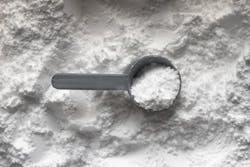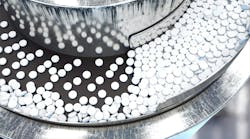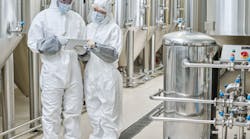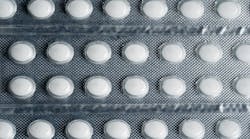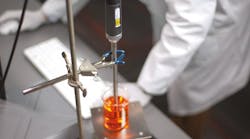Some pharmaceutical manufacturing processes have remained virtually unchanged for decades. But when new therapies hit the scene, their arrival can help spur manufacturing innovation.
For example, catalysts like the U.S. government Precision Medicine Initiative incentivize the development of personalized medicine, which require new manufacturing processes. So as pharma manufacturers prepare operations for handling these new therapies, they are looking at ways to tweak their processes as well. One helpful target for process updates is powder technologies.
Many pharmaceutical products utilize particle/powder technology in some step of their manufacturing process. Importantly, the physical properties of these powders have implications for the necessary production equipment, manufacturing process, and quality of the final product. So, as materials science has progressed, new technologies have been developed to create and control particles at the micro- and nanoscales.
In the case of formulations, the use of micro/nanoparticles as drug delivery systems (DDS) allows particle designs to be tuned on a case-by-case basis. But, conventional empirical methods are too cumbersome for designing personalized medicine formulations that meet quality standards, which is triggering the adoption of newer quality by design (QbD) methods.
Manufacturers need to reduce the number of processing steps, increase efficiency, and integrate drug manufacturing. For these reasons, custom formulation design and manufacturing innovations are both needed to produce quality personalized therapies — nanoparticles and on-demand manufacturing advancements may hold the key to meeting these goals.
The promise of nanoparticles
in the creation of common drug delivery systems such as tablets, capsules, dry-powder inhalation, suspensions and emulsions. The constituent powders and particles can be specialized to meet patient needs. Functionalized particle formulations that increase bioavailability or improve physicochemical properties are already commercially available. Nanoparticles, however, may offer a greater degree of fine-tuning for drug delivery.
A primary challenge in drug delivery is interaction with mucus. In the body, many cavities and internal organs are lined with mucus, which is affected by food, health, and environmental factors. Asthmatic people, for example, have mucus layers several times larger than healthy people. Designing a drug delivery system to properly interact with the mucus layer at the target ailment location for a specific patient is critical for personalized medicine.
Nanoparticles may offer a solution. Pulmonary nanoparticles have been used to improve the pharmacological efficacy of medications for treating asthma. Nanoparticles are highly customizable because their surface chemistry can be modified in a myriad of ways. Future nanoparticle designs can be configured to fit each disease, organ and patient. The properties and thickness of the mucus layer of an individual patient can be determined, and a personalized DDS can be designed and manufactured. There are some existing techniques for improving nanoparticle-mucus interaction, like adding mucoadhesive polymers to the surface of the nanoparticle, but further research and development needs to be done in nanoparticle surface modification.
After passing through the mucus layer, the nanoparticles interact with epithelial cells. Some drugs, like nucleic acid medicines, need to be delivered into cells, so the nanoparticles need to be designed with the capability to access cells directly. For example, a nanoparticle can be engineered with a positive charge on its surface to attract the negatively charged cell membrane. This attraction increases the likelihood for nanoparticles to be taken into cells.
Since surface properties affect both mucus and cell interaction, designing the nanoparticle surface carefully is critical to drug delivery efficiency. Tailoring surface properties to specific cells is especially challenging, because cells behave differently in vitro versus in vivo. If design difficulties are overcome, the customization possible with nanoparticles is a huge boon for personalized medicine.
Quality control and particle design
Conventionally, developing drug formulations has been done by trial and error. Formulations are created and then tested to ensure they meet the quality requirements of regulatory authorities like the U.S. Food and Drug Administration. To improve upon this “quality by test” process, the FDA has encouraged the use of quality by design (QbD) processes. The objective of QbD is to remove guesswork from creating manufacturing processes by taking the end objective into account. QbD methods are essential for quality control in decentralized personalized medicine manufacturing, and QbD methods are already being applied to nanomedicine manufacturing processes.
Pharmaceutical QbD is based on how different manufacturing parameters, like raw materials and particle size, affect the final product. QbD is already partially used in solid formulation production, which relies on devices to measure intermediate properties like powder blending, powder drying and particle size distribution. These properties are measured at each manufacturing stage to verify they are in the acceptable range for the following stage. This prevents error propagation from early processes and can inform cases where quality does not meet standards.
To fully bring QbD to the pharmaceutical industry, new and improved practices, such as design of experiment, risk assessment, and process analytical technology (PAT), are required. Current PAT tools cannot adequately monitor crucial parameters like nanoparticle size, surface properties, adhesion, fluidity, or other properties needed to fully implement QbD.
In the absence of an adequate PAT tool, the manufacturing process can be simulated for better understanding. A digital design approach can also circumvent the need for trial and error. When large amounts of data are available, statistical models and machine learning can assist QbD and guarantee drug quality.
Spherical crystallization for advanced manufacturing
Though the pharmaceutical industry has historically used batch production, there has been some shift to continuous production to remove the gap between lab-scale and plant-scale manufacturing. Continuous production contrasts with batch production in that the materials are always in motion. From raw materials to the final product, all steps of the process are continuously occurring, and the materials are always undergoing motion or chemical reaction.
Continuous production allows manufacturing systems to be miniaturized since they can run 24 hours a day. This is critical for personalized medicine, where manufacturing devices would be deployed to pharmacies and doctor’s offices. There are a few continuous manufacturing tablets already on the market. Continuous production methods can soon be applied to active pharmaceutical ingredient (API) manufacturing and may combine manufacturing and formulation processes.
This process integration hinges on the crystallization step, which is included in about 90 percent of API production processes. Since crystallization occurs early in the process, crystallization errors can propagate to later steps. Powder properties like flowability and compressibility can adversely affect powder processing, so a granulation process is often employed to improve powder-handling properties.
Spherical crystallization can improve the crystallization and filtration/drying steps of previous manufacturing processes while completely removing the granulation step. Spherical crystallization increases crystal size via agglomeration, which aggregates jagged crystals into spheres. This increases efficiency by combining two manufacturing steps into one and boosts quality by generating powders with better handling properties than conventional granulation-aggregated powders.
Process intensification and miniaturization
Continuous production methods enable miniaturization that was previously not possible. To demonstrate this, researchers at Massachusetts Institute of Technology designed an on-demand continuous-flow production of pharmaceuticals in a compact, reconfigurable system around the size of a refrigerator. The system is designed to produce thousands of oral or topical liquid doses of several APIs. This means that, one day, doctors might be able to produce personalized medicine for patients on the spot. Similar small-scale drug manufacturing systems could soon address challenges like natural disasters, pandemics and more.
Additive manufacturing has also proven its value in personalized medicine. The customization inherent to additive manufacturing techniques, such as 3D printing, makes them ideal candidates for creating small batches of personalized medicine. Research has already shown that 3D printing can produce complex drug-release profiles. The primary drawback, however, is that APIs have to be processed in a way conducive to the additive manufacturing technique. Powder properties like particle size distribution and powder flowability have to satisfy strict constraints to be usable for 3D printing. For certain APIs, these constraints may be difficult to meet.
Key takeaways
New manufacturing methods bring various engineering and regulatory challenges. Quality control is difficult when there is no centralization, but this can be addressed using QbD with PAT tools and automation.
There is potential for a complete revolution in the way patients receive medicine. If numerous hurdles are overcome, the inflexibility of conventional bulk manufacturing can be replaced with the agility of continuous and on-demand manufacturing. These new technologies can solve problems that conventional bulk manufacturing cannot, including orphan drugs and custom pediatric formulations. Doctors could design treatments tailored to each specific patient, and patients could receive their treatment before leaving the doctor’s office.
Technological advancements in nanoparticle design and the requisite powder manufacturing technologies to create these formulations on-demand will be integral in making this goal a reality.
